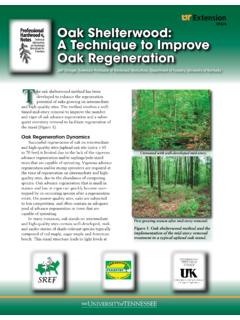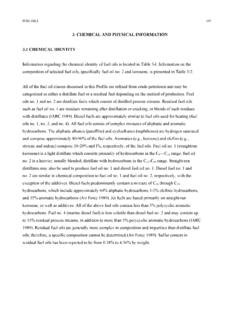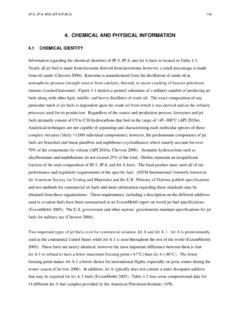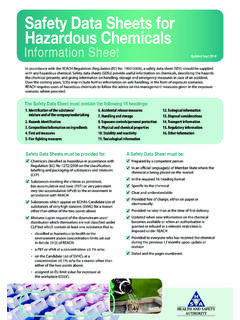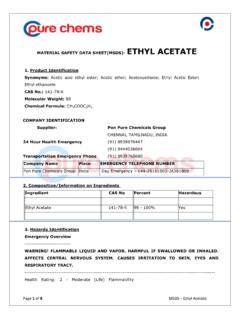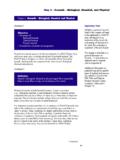Transcription of PHYSICAL AND CHEMICAL CHANGES - UT Extension
1 MANAGEMENT OF APHIDS AND BYD IN TENNESSEE WHEAT1 PHYSICAL AND CHEMICAL CHANGESW 401 Savannah Webb, Former 4-H Extension Agent, Maury CountyJennifer Richards, Assistant Professor, 4-H Youth Development 3 PHYSICAL and CHEMICAL CHANGES Skill Level Beginner Learner Outcomes The learner will be able to: Explain the difference between a PHYSICAL and CHEMICAL change. Educational Standard(s) Supported : Evaluate the results of an experiment to determine whether the mixing of two or more substances result in a change of properties. Success Indicator Learners will be successful if they: Identify the five factors that indicate a CHEMICAL change has occurred.
2 Give at least two examples of a PHYSICAL change. Classify a change as either PHYSICAL or CHEMICAL . Time Needed 15-20 Minutes Materials List Playdough, M&M s, 6 percent hydrogen peroxide, 16 oz. water bottle, dry yeast, warm water, liquid dish soap, food coloring, pie pan, funnel, small cup or bowl. Introduction to Content Author Webb, Savannah. UT Extension Maury County. Tennessee 4-H Youth Development A PHYSICAL change is any change in a substance s form that does not change its CHEMICAL makeup. Examples of PHYSICAL CHANGES are breaking a stick or melting ice. A CHEMICAL change, or CHEMICAL reaction, occurs when atoms of a substance are rearranged, and the bonds between the atoms are broken or formed.
3 During a CHEMICAL reaction, the structure or composition of the materials change. When a CHEMICAL change is complete, the resulting substance(s) is/are different from the original substance(s). As a result of a CHEMICAL reaction, new substances with new properties are formed. Introduction to Methodology In this lesson, students will learn about PHYSICAL and CHEMICAL CHANGES . PHYSICAL CHANGES will be demonstrated with playdough and/or M&M s Candy. The CHEMICAL change will be demonstrated by making Elephant s Toothpaste. Setting the Stage and Opening Questions Have students watch the YouTube video Everything is changing! (Parody of bruises by Train).
4 A song about PHYSICAL and CHEMICAL CHANGES . ( ) Use video as a springboard to start discussion on CHEMICAL and PHYSICAL CHANGES . Begin discussion by having students repeat the differences in the two CHANGES heard in the song. Provide a more detailed explanation of PHYSICAL vs. CHEMICAL CHANGES . Write differences on the board. Have students write differences in their science journals or on a clean sheet of paper. o PHYSICAL Change A change that does not result in the production of a new substance. PHYSICAL CHANGES result only in a change in the form ( , solid, liquid, gas) or appearance of a substance, but not the CHEMICAL composition of the substance.
5 The substance will still ultimately be the same. Once a PHYSICAL change occurs, it can be reversed. Example You take an ice cube out of the freezer and put it in your glass. Whoops! You forget to pour your drink. You come back a couple of hours later and find your ice has melted. This change in the state of water is an example of a PHYSICAL change. When your ice melted, it became water. Can you reverse this change by refreezing the water? Yes! o CHEMICAL Change A change that results in the production of a new and different substance. These CHANGES are often indicated by one of these factors: color change, a gas is given off, a new substance is formed, heat is given off (.)
6 We call this an exothermic reaction), and/or heat being absorbed (.. we call this an endothermic reaction). CHEMICAL reactions, once they occur, are irreversible. Example I eat an apple. When I am finished with the apple, I put the core in the compost pile. Over time the apple rots and becomes compost material. This is an example of a CHEMICAL change because you cannot change the compost back into an apple core. Reshow the YouTube video to reinforce the concepts of PHYSICAL and CHEMICAL CHANGES . After video is shown, have students quickly illustrate in their science journal notes the examples of PHYSICAL and CHEMICAL CHANGES that were in the song.
7 Ask students: What are some examples of PHYSICAL CHANGES ? What about CHEMICAL CHANGES ? What makes a PHYSICAL change different from a CHEMICAL change? Are PHYSICAL CHANGES reversible? What about CHEMICAL CHANGES ? Tips for Engagement Introduction of basic concepts is necessary before beginning demonstrations. This helps students mentally process what they are seeing. While doing demonstrations, point out at each stage how what is happening makes the reaction a CHEMICAL or PHYSICAL reaction. Terms and Concepts Introduction PHYSICAL Change Change in form or appearance that can be undone. CHEMICAL Change Formation of new substances that cannot be undone.
8 Catalyst A substance that increases the rate of a CHEMICAL reaction without itself undergoing any permanent CHEMICAL change. Exothermic Reaction A CHEMICAL reaction that releases energy in the form of heat or light. Endothermic Reaction A reaction in which the system absorbs energy. Experience Demonstrate a couple of PHYSICAL CHANGES . o You have a pile of brown M&M s and a pile of red M&M s. You slowly add the red M&M s to the brown M&M s pile. Ask students, Did this change result in the formation of a new substance? No! The M&M s are still M&M s after adding the red ones. The only difference is the appearance has changed. Could you reverse this change?
9 YES! o You take playdough and roll it out into a snake-like shape. You decide to cut the snake in three smaller pieces. Ask students to identify what type of change this is. This is a PHYSICAL change because you changed only the shape and size of the snake. Life Skill(s) from TIPPs for 4-H 5th Grade Participate in 4-H club meetings by saying pledges, completing activities and being engaged. (Head) Share Have students share about the following question. What did you observe in the CHEMICAL reaction? Apply Share with the students: The rate at which hydrogen peroxide decomposes depends on temperature, the concentration of the hydrogen peroxide, and light.
10 So what special precautions are taken with hydrogen peroxide to keep it from spoiling? Process Ask students: What is the difference between an endothermic and an exothermic reaction? Generalize Have students brainstorm about this question: How do we know a CHEMICAL reaction occurred in the Elephant s Toothpaste experiment? Ask the students: What was the purpose of the yeast in the experiment? References You Be the Chemist: Lesson Plans for Making Chemistry Fun. The CHEMICAL Education Foundation. Retrieved July 23, 2015. Elephant s Toothpaste. Ruben Meerman. ABC Science Online. Retrieved July 23, 2015. Demonstrate a CHEMICAL change with the Elephant s Toothpaste Experiment.




